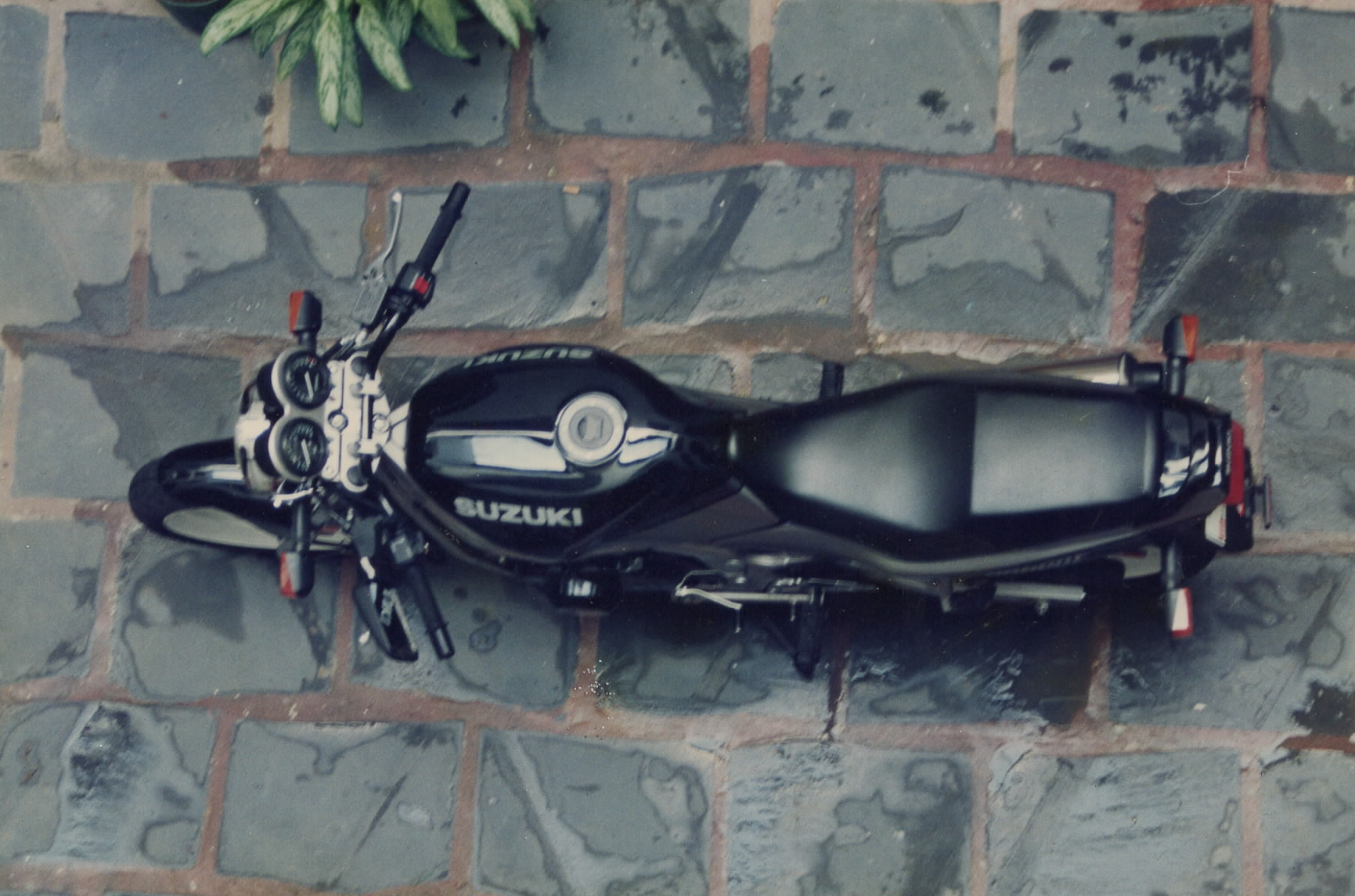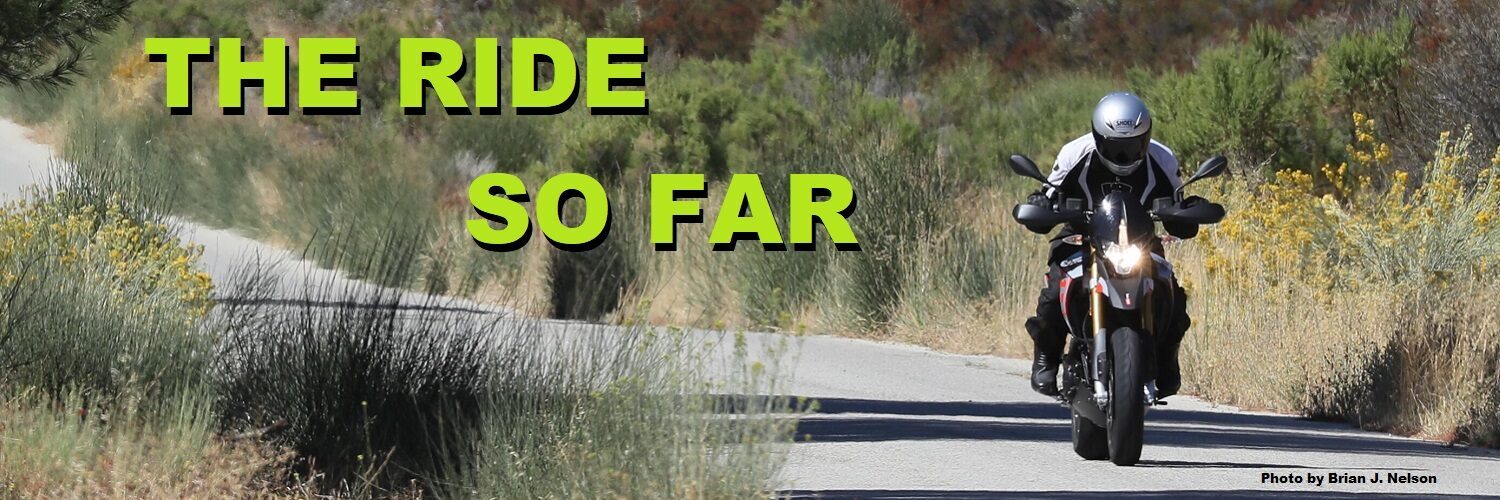In geologic time, an epoch may last hundreds of thousands of years or millions. Looking back at my own motorcycle-owning and riding life, I see clear epochs of much shorter duration, defined by the predominant motorcycle for that time, just as geologic epochs are known for the kinds of living things that flourished then. This all came to mind because a personal epoch just ended. I just sold my Honda VFR800 Interceptor Deluxe, my primary motorcycle for the past five years and two months, and thus the defining element of my motorcycling life in that time period.
Of course for many of us who spend way too much of our time thinking about motorcycles, the fun part of selling one is deciding what we’ll buy to replace it. So I’ve been revisiting my previous personal motorcycling epochs to see how that history may inform my future choice.

When I moved to Puerto Rico in 1992, the first thing I bought was a Suzuki GS500E so I’d have a way to get to my new job. There was nothing at all remarkable about the GS500, seen here after getting a wash in the courtyard of my apartment building. But it was suitably nimble for lane-splitting my way through San Juan traffic and fun enough for exploring the tight mountain roads of my new tropical home.
The prehistoric epoch
My first motorcycle was a used 1976 Honda CB360T, a humble ride indeed, and several unremarkable motorcycles followed it. The prehistoric epoch covers my college years to my mid-30s, including one dark period when I graduated college and had to sell my motorcycle to fund the purchase of a car that was required for my first job, leaving me without a motorcycle for a time.
The closest I came to owning anything interesting in the prehistoric epoch was the original Yamaha Virago 750, which had some significance as the first Japanese attempt to take on Harley-Davidson directly by building a cruiserish motorcycle with a V-twin engine, and later a Harley-Davidson 883 Sportster, the classic but often derided entry into the H-D line. More typical of the epoch was the utilitarian Suzuki GS500E I bought when I landed in Puerto Rico and literally had a few days to find a place to live and procure personal transportation before starting a new job. It was relatively cheap, useful, and the kind of bike nobody gave a second glance.
That’s why this is the prehistoric epoch. There was no single significant motorcycle to define it.

The Speed Triple and I both looked a lot younger in 1998. Buying it was a step toward getting even more serious about motorcycling. The next step was getting a job in the industry. The Speed Triple’s epoch lasted more than a decade, and it’s still with me today.
The Speed Triple epoch
Over at Common Tread, I’ve written in more detail about how a bit of an unexpected windfall and a bout of hard work led me to decide to drop a bigger than usual sum of money (for me) on a motorcycle that was actually desirable. That led to the purchase of my 1997 Triumph Speed Triple, which was my primary motorcycle during the most major changes in my riding life. My wife and I moved from Puerto Rico back to Ohio, where I worked at the AMA and suddenly had access to press bikes, professional training, and some amazing experiences in the motorcycle industry. Other motorcycles came and/or went, from the little Honda NX250 that was my ideal rat bike, to the garage-queen Triumph Daytona 675 mostly used for sunny track days, and the BMW F650 I rode into Mexico. But the Speed Triple was clearly the defining motorcycle of the epoch, if not my entire riding career. Just as crocodiles date to the time of dinosaurs but are still with us today, the Speed Triple is still with me, after its epoch as primary ride ended. Its epoch was superseded by…

In the first month I owned the Versys 650, I took a trip from Ohio to Maine and back, hitting some favorite spots along the way, such as Hawk’s Nest in the Delaware Valley of New York.
The Versys epoch
The Versys epoch was shaped by a few factors: the Speed Triple reached 80,000 miles and I wanted something newer and more suited for travel and I had left my job at the AMA to return to freelancing, which always demands a more cautious approach to spending. I decided to build a do-it-myself lightweight sport-tourer. I found a leftover new 2009 Kawasaki Versys 650 in May of 2010 for just $5,000 and added Givi luggage, handguards, and heated grips for a few hundred dollars more. I put 3,000 miles on it in the first month I owned it. I rode it locally until it was due for the 600-mile break-in service and then loaded it with camping gear and took a trip from Ohio to my sister’s house in Maine and to other points along the way. In the end, I can say I never got my money’s worth out of anything more than the Versys, riding it for eight years, 11 months, and 89,941 miles. It was capable, inexpensive to own and insure, and only let me down once.
The Versys epoch was one characterized by garage stability. For nearly a decade, I had the Speed Triple, Daytona, and Versys with no change in the lineup. But with the Versys approaching 90,000 miles, its epoch came to an end.

After I finally tracked down a used 2014 Honda VFR800 Interceptor Deluxe and an equally rare set of the discontinued original equipment panniers, I set about taking trips on the first genuine turn-key sport-touring motorcycle I’d owned.
The VFR800 epoch
The Versys served me well, but it had its limitations. I couldn’t have done better in terms of bang for buck, but it was, after all, a fairly low-bucks motorcycle. It never felt refined. It was a sport-tourer as built by me, on a budget, not by expert engineers at a major motorcycle manufacturer. A decade on, I had savings to spend and a desire for a turn-key sport-tourer. After considering several options, I settled on a Honda VFR800 Interceptor Deluxe. They were hard to find because not only were they discontinued in the United States, but they also never sold well to begin with. Plus, I specifically wanted the Deluxe, which had the adjustable suspension, rudimentary traction control, heated grips, and center stand the base model lacked. Eventually I found one, tracked down the discontinued matching panniers on eBay, and had my first real sport-touring motorcycle.
To be fair, the VFR served me well. Unfailingly reliable and subjectively far classier than anything I’d owned before. But it also reinforced some truths about myself. Despite the Helibars inserts added by the original owner, the somewhat sporty riding position left me with a tired, sore neck on the long days I often used it for. As you can see from the list above, I’ve always favored light motorcycles, and that bias only grows stronger with age. The VFR could be lighter. I rediscovered how much I dislike clam-shell-style panniers, which were also quite expensive, in my case. I confirmed that I don’t like full fairings enough to keep me from getting annoyed at having to remove them for any kind of maintenance. Still, despite my quibbles, I had no plans to sell the VFR.
Then a rider who lives just 150 miles from me read my article about buying it and contacted me with some questions about the eighth-generation VFR because he was shopping for one to replace his beloved sixth-generation VFR that had surpassed 100,000 miles. Like me five years ago, he knew what he wanted but was having a hard time finding one, because it was so uncommon. Over the course of an e-mail conversation, I mentioned that I had considered selling mine.
We eventually agreed on a deal and completed the sale last week. I think the buyer, me, and the VFR are all better off. I can find something a little lighter and less complex for my old age, he has the exact model he wants (though he’d probably prefer one with fewer scratches and miles — mine had 45,003 miles on it when I handed him the key), and the VFR will probably be better cared for under his ownership.
The next epoch
So what’s next? My garage is now down to the eternal Speed Triple and the Comoto-owned BMW G 310 GS I have on loan. Just as when I opportunistically sold the Versys, I’m without a motorcycle new enough, reliable enough, or comfortable enough to be optimal for long-distance travel (though the BMW is better than you might think). But that’s OK, because the shopping and researching is part of the fun.
The easy route would be to buy another turn-key sport-tourer, and the Suzuki GSX-S1000GT+ I tested is an obvious contender. But then I’m back to full fairings and clam-shell panniers, when I’m really a sport-naked-motorcycle kind of guy. So I may try to take a middle path between the VFR epoch and the Versys epoch. I may go back to a do-it-myself sport-tourer that’s lighter than the VFR, that I can fit with top-loading panniers, and that doesn’t require me to spend more for a routine valve service than I paid to buy my first motorcycle. But as a base for this project I’ll start with something a little more refined than the Versys 650.
We’ll see. As stated up top, an epoch lasts hundreds of thousands of years, at least, and replacing the Versys took me 11 months. Hopefully, a new epoch will begin sooner, this time.
